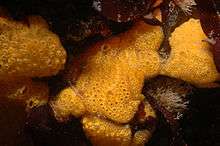Botrylloides violaceus
Botrylloides violaceus is a colonial ascidian. It is commonly known as the chain tunicate,[2] but has also been called several other common names, including: lined colonial tunicate, orange sheath tunicate, orange tunicate, and violet tunicate.[3] Its native range is in the northwest Pacific from southern China to Japan and Siberia.[4] Colonies grow on solid substrates and consist of individuals arranged in twisting rows. Outside its native range, it is considered an invasive species and is becoming more common in coastal waters of North America and other waters around the world, likely being spread by shipping industries.[5]
| Botrylloides violaceus | |
|---|---|
 | |
| Botrylloides violaceus | |
| Scientific classification | |
| Kingdom: | |
| Phylum: | |
| Subphylum: | |
| Class: | |
| Order: | |
| Family: | |
| Genus: | |
| Species: | B. violaceus |
| Binomial name | |
| Botrylloides violaceus (Oka, 1927) [1] | |
In the San Francisco Bay area, B. violaceus can be readily found on boat docks in the Richmond Marina. The ecological impact of B. violaceus in this region remains unknown.
Morphology
Zooids are embedded in a transparent tunic and connected by a network of blood vessels that terminate in ampullae (small sac-like structures) at the periphery of the colony. Colony color varies from bright orange to reddish or dull purple. These tunicates usually have 8 branchial tentacles and 11 rows of stigmata.[6]
Significance and Interest
Colonial ascidians are the only known chordates capable of regenerating all body tissues [whole body regeneration (WBR)]. Because of chordates' close developmental relationship to vertebrates, the regenerative processes in colonial ascidians are of great interest to researchers. WBR can be observed in B. violaceus after removal of all body tissues except the peripheral vasculature, suggesting the presence of circulating pluripotent or totipotent stem cells in the blood.[7][8]
References
- Gittenberger, Arjan (2015). "Botrylloides violaceus Oka, 1927". WoRMS. World Register of Marine Species. Retrieved 2016-02-25.
- Lorne Curran and Samuel Chan. "Invasive tunicates in the Pacific Northwest" (PDF). Oregon Sea Grant.
- "Purple Colonial Tunicate (Botrylloides violaceus)". WhatsThatFish.
- Cohen, Andrew N. (2005). "Botrylloides violaceus". Guide to the Exotic Species of San Francisco Bay. San Francisco Estuary Institute. Retrieved 2009-03-03.
- Fuller, Pam (2006-04-24). "NAS - Species FactSheet (Botrylloides violaceus)". USGS Nonindigenous Aquatic Species Database, Gainesville, FL. Retrieved 2008-03-14.
- "Fact sheet 15" (PDF). NON-INDIGENOUS AQUATIC SPECIES OF CONCERN FOR ALASKA. Prince William Sound Regional Citizens’ Advisory Council. 2004. Archived from the original (PDF) on 2010-11-27. Retrieved 2009-03-04.
- Brown, Federico (2009). "Whole body regeneration in a colonial ascidian, Botrylloides violaceus". Journal of Experimental Zoology Part B: Molecular and Developmental Evolution. 312B (8): 885–900. doi:10.1002/jez.b.21303. PMID 19588490.
- Rinkevich, B (1995). "Whole-body protochordate regeneration from totipotent blood cells". Proceedings of the National Academy of Sciences. 92 (17): 7695–7699. doi:10.1073/pnas.92.17.7695. PMC 41212. PMID 11607571.